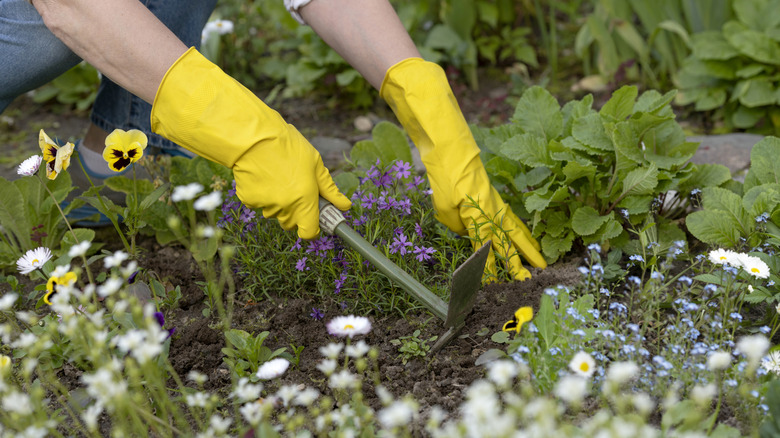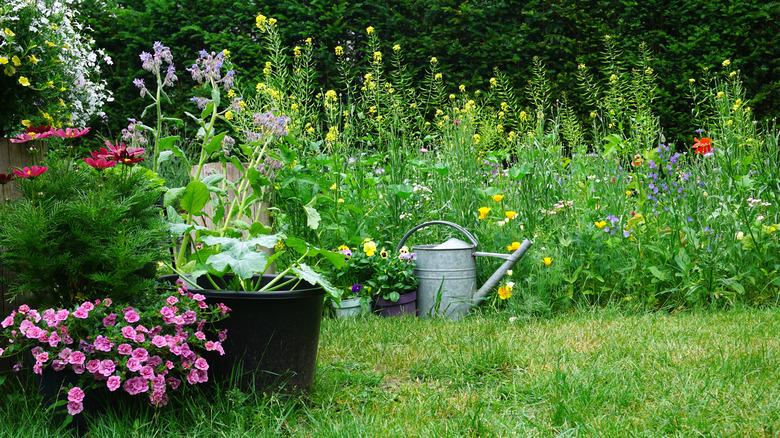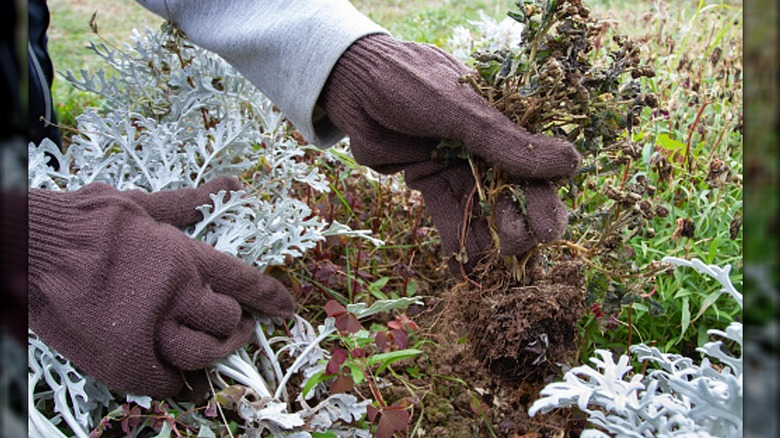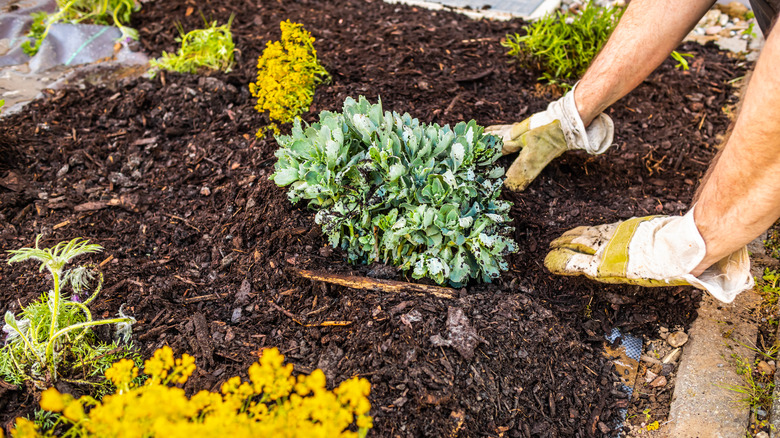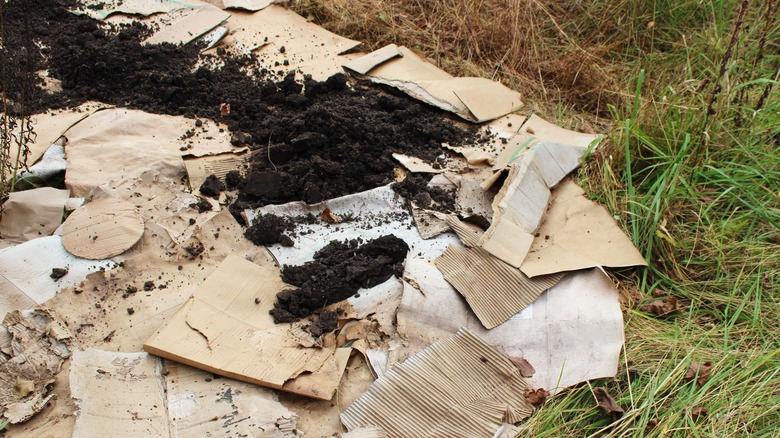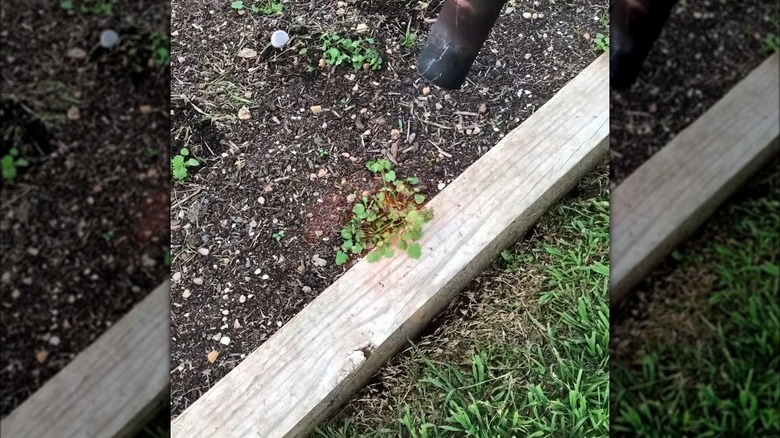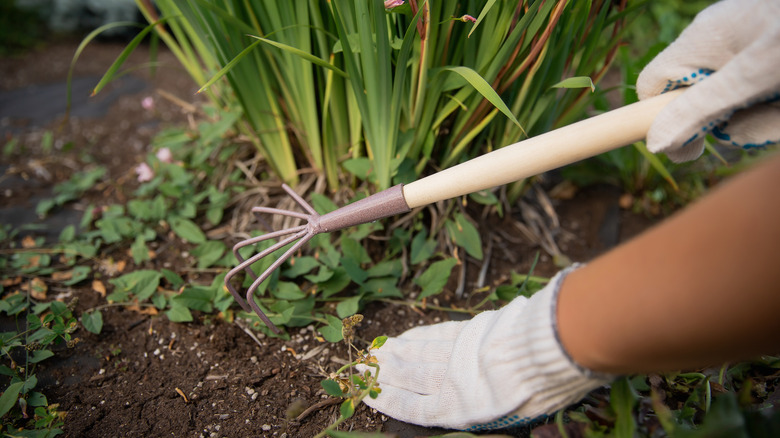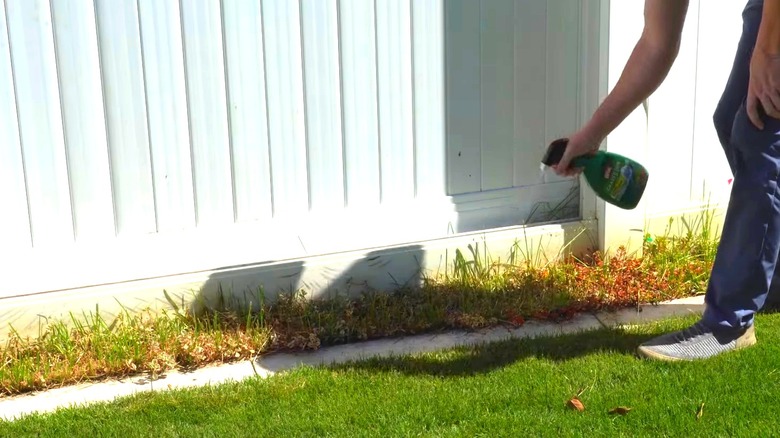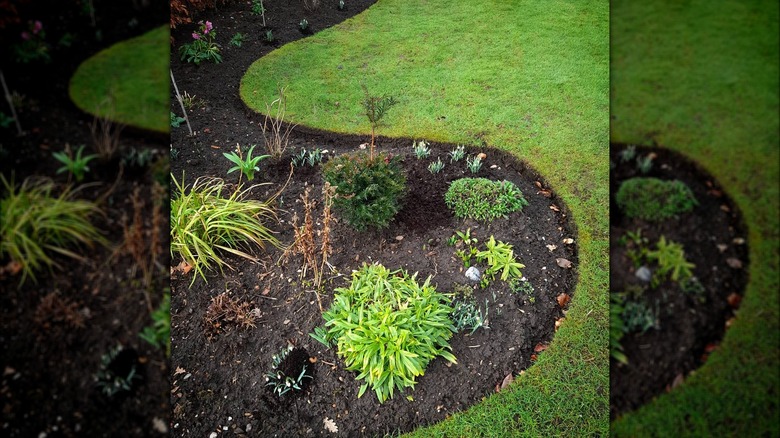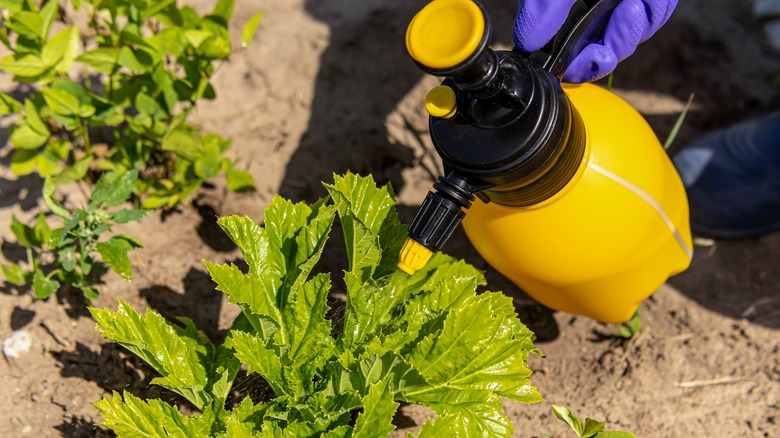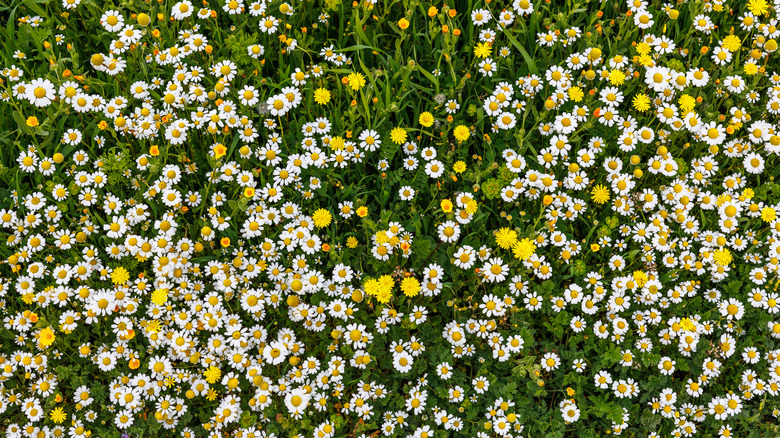A Thorough Guide To Kill Grass In Flower Beds & Keep It From Coming Back
Emerald hue, velvety touch, manicured neatness, and cushiony resilience are attributes you would want in a lawn meriting envy — not in your flower beds. When grass invades your garden it's as good as any weed, robbing the florets of water, nutrients, and the sun's warmth, or infecting them with diseases, egging them on down a road that culminates only in an untimely demise. In short, you want it gone, and gone for good; the sooner, the better. Unfortunately, killing grass in flower beds is complicated, as what works on the green blades can work on desirable plants, too. For instance, scalding undesirable growth with boiling water may be one of the least harmful ways to kill weeds in your lawn, but is not effective in ornamental beds, according to the University of Maryland Extension. In addition to your flowers, it might also kill the soil's beneficial insects.
Similarly, DIY soap, vinegar, and salt solutions risk damaging the ornate beds by inducing salt build-up. Mowing the grass will yield minimal success since the mower can't eliminate the lower growth points, enabling it to rear its pretty head again. As you can hazard, the path from grassy intrusion to grass-less flower beds has fewer pitstops than usual suspects, limited to the likes of manual removal, smothering, heavy mulching, cultivation, herbicide treatments, and flaming, as we explain below. But that's not it — you must also take preventative measures post-riddance.
Identify and understand the grassy weed's life cycle
Before delving into the methods, it's important that you ID the invading grass, as your success (or failure) heavily rides on its lifecycle. Plenty of identification guides are available online, such as this one from Oregon State University, but if you're unsure, you can seek help from your local extension service or a local master gardener. Generally, most flower beds are raided by annual grasses, the type that die back from the winter chill after dropping seeds into the soil, such as annual bluegrass, crabgrass, and goosegrass. Other times, though, aggressive perennial grasses may take over your floral patches, especially if they've jumped from your lawn or crept from the neighboring side. Bermudagrass, quackgrass, and zoysiagrass are common interlopers, depending on the zone you're inhabiting, and are much harder to control.
In a similar vein, classify whether your garden bed is annual, perennial, or mixed, as this will limit the elimination methods at your disposal. Simply put, it's easier to banish grassy weeds from annual beds with mulches and frequent cultivations. In contrast, as perennials return year after year, cultivation might not be a plausible solution, forcing you to pin all hopes on smothering with mulch or inorganic materials. Mixed beds will require a combination of these methods to yield effective results, with herbicide treatments being the final option in all cases.
Pull out the invading grass manually from the flower beds
Physical removal may be laborious and back-breaking. Yet, it is one of the most eco-friendly ways to send colonizing grasses packing from your ornamental patches. So, the next time you're walking through your yard, breathing in the sweet fragrance drifting from the flowers, and enjoying the butterflies being indecisive about which plant's nectar they like the best, take a moment and scan the beds for any popping green blades. Mark the spot, and return to it after a deep soak, either by hose or downpour, as pulling weeds from dry soils is difficult. Coax the grasses out with your hand, ensuring no roots get left behind and return to avenge their family's (untimely) removal. Tackle the weeds while they're still establishing themselves. This method works best on grasses without creeping runners, such as fescue or ryegrass.
Understandably, using hands to pull out the weeds is only feasible in small garden beds, unless you're up for a challenge and are willing to work through a bigger patch in sections early in the morning. Hereon, you're better off switching to a hand-held, solid-blade, or stirrup tool. Hori-hori knives work, too, for digging out undesirable growth. Expect to repeat the process multiple times if the grasses have gone to seed, although mulching the area may check their germination.
Suppress the weedy grasses with heavy mulches
Like your flowers, the verdant invaders require sunlight to grow and carry forward their colonization mission. So, if you cut off their access to the rays, they'll end up exhausting all their reserves and wither to death. Their seeds may remain unviable for that duration too. But how do you achieve that? Enter mulches. To make this work, spread the mulch that is best at preventing weeds, aka spread bark mulch, on the infestation. It'll blend perfectly in woodland gardens. Pine needles, straw, and wood chips are other alternatives unless the intruder at hand is bermudagrass which, to put it lightly, laughs in the face of wood chips, rising valiantly from their destroyed selves. Also, resist using seed-harboring mulch, such as grass clippings (especially from your lawn!) and hay.
Lay the mulch 2 or 3 inches thick if you're growing woody plants; go down to 1 inch in case the plants are shallow-rooted (think rhododendrons and azaleas), or herbaceous perennials. Follow this method for two growth seasons (or more if necessary) to kill the transgressing perennial grasses fully. In case any weed resists control and shoots out of the mulch, hand weed. Reapply if you notice any seeds germinating (possibly carried in by birds or winds).
Smother intrusive grasses with newspapers, cardboard, or plastic sheets
Since mulching is insufficient against pernicious grasses, such as bermudagrass and couchgrass, supplement it with pieces of newspaper or cardboard for better results. The aim is to piggyback on the additional layer to preclude the just germinated or young weeds from accessing any light. Before starting, ensure you irrigate the infested area. Once you're satisfied, overlay around six newspaper sheets (or two cardboard pieces) at a site and wet them slightly to keep them in place. Next, cover the overlapping newspapers with a 2-inch thick layer of organic mulch like bark or compost and wait for the grasses to rot (may take up to 8 weeks). If carrying out the process in an actively growing bed, tear off the newspaper around the flowering plant's dripline before laying. Ideally, you should see no more grassy weeds over the next quarter. In case you do, pull it out and replace that area's newspaper, starting over.
You can also smother weeds effectively for a beautiful flower garden with a clear, UV-resistant plastic sheet, aka solarization. Here, the sheet prevents the grasses from absorbing water while cooking them in the sun's heat, eventually exterminating their existence. Or, like newspapers, you can cover it with mulch for added weight. Don't go overboard, though, as the accumulated heat and blocked airflow can damage your soil's profile by baking the beneficial microbes.
Singe the grassy weeds with a propane torch
A propane torch is the heavy-duty tool that will kill pesky weeds in your garden. It can work its magic on intrusive grasses as well, provided you time it right and time it well. The process is pretty similar — simply direct its hot flame at the green gatecrashers. Don't worry, the grasses won't turn into smoke even though watching them go poof would hearten plenty. Instead, as the weedy plants are heated, their sap will expand, fracturing the cell tissues and robbing them of all chances of recovery. Consequently, your flower beds will be grass-free in a few days.
There are a few caveats. For starters, flame weeding lends better to young seedlings, meaning the ones that are barely touching 2 to 3 inches in height. Also, as most grasses have coleoptiles (protective sheaths at the first leaf's base), you'll need multiple passes every other week to successfully nip the problem into the bud along with cultivation. Besides, propane torches shouldn't be used around incendiary materials like mulch, dry leaves, and ornamental grasses, given the fire risk. This relegates their use to early spring when the annual beds are due for planting, although the grasses have already made their existence apparent. Or in beds bordering a sidewalk, driveway, or garden path. Don't forget to wear protective clothing, and don't seek out grassy weeds when it's windy.
Shallow cultivate the weedy beds
Another way to dispatch grass from your flower beds is to cultivate the usurped area using a garden fork or a powered rotary tiller — even better if performed monthly. It will also minimize the time and toil spent on hand weeding. Naturally, tilling annual beds is easier versus perennial patches, as you can exploit the time when you're rotating in new plants. All you need to do is fork the soil when it's damp to touch but no deeper than 2 inches. Otherwise, it may unearth a host of grass seeds ready to germinate and amplify the existing problem. Also, work the soil with a light hand since you only want to unroot the growing grasses, not thrash away at your desired plants. Afterward, use a gardening rake to tumble the soil so that the remaining upturned seedlings show up on top, ripe for removal. Mulch heavily to overwhelm any errant grassy weeds.
However, if you've identified the garden marauder as bermudagrass, tread carefully with cultivation, as they spread prolifically from the tiniest root segments. A better option would be to stop watering the infested area altogether (assuming it won't kill your non-target, drought-resistant ornamentals), and raking it after it's parched dry. Repeat the process a couple of times through the summer, but skip this method altogether if you foresee any rain or are dealing with wet soils.
Apply post-emergent herbicides as a last resort
When everything fails, you might have to look to post-emergent herbicides to rescue your precious petals. Fortunately, numerous options are now available that selectively kill the grasses without targeting other flowering plants like iris or liriope (they won't kill other weeds, though). The key is to look for herbicides containing Sethoxydim as an active ingredient, such as Grass Beater, Grass-b-Gon, Over the Top II Grass Killer, or Ornamec. They're effective against extremely wicked wiregrasses and crabgrasses, too. But if annual bluegrasses are invading your garden patches (ID to make sure!), switch to herbicides with clethodim as their main ingredient — Envoy is a good option. Fluazifop-based herbicides (think Fusilade II) can be effective against zoysiagrass and tall fescue. Acetic acid-containing organic herbicides, such as Weed & Grass Killer or Vinagreen, may offer some control, but blend with a surfactant.
Follow the herbicide's label to the letter, especially on the best time and method to use it and the plants it shouldn't be used around. For instance, grass-selective chemicals can't be used in beds decked in ornamental grasses. Similarly, spray only actively growing, healthy grasses — spring or fall works. For annual grasses, use the chemicals before cultivation. Watch for drift and rain, as you don't want to aggravate environmental contamination; fencing the plants with buckets and sponging or wicking rather than spraying might be of assistance. Repeat applications may be necessary, depending on the infestation's size.
Place edging around the flower beds
Getting rid of the grasses is only half the battle; ensuring they don't return is another — edging helps with the latter. Copious grasses spread through runners, which works spectacularly for establishing a lawn, but creates a weedy issue in light of how a few creep over a 1-foot-long distance until they end in garden beds. While edging will not purge the problem completely for if an aggressive grass wants to spread it will do so without regard for your feelings, but it will scale down the problem. Additionally, it'll inject your yard with the regimented neatness you have probably come to associate with turf. Controlling soil leaching is another bonus.
The best part, though? Edging doesn't have to be expensive. You can just dig a 6-inch deep, V-shaped trench with a flat spade. That way, the unruly grasses tingling to be amidst your flowers might never find their way. Other garden edging ideas include upcycling empty bottles or thrifted vintage plates for a decorative touch. Hardscaping elements, such as pavers, bricks, stones, wood, metal, and black plastic, may also be used to create edging strips. But make sure to level them with the turf's desired height and that they're dug at least 2 inches deep into the ground. Mowing strips are also popular.
Spray pre-emergent herbicides on need-basis
Spraying pre-emergent herbicides on your newly prepared garden beds does them a world of good, provided you've already taken care of the previous season's grassy remnants. That's because they permanently break the vicious cycle of annual grasses, preventing any dawdling seeds from maturing and posing trouble. Common options span the likes of Treflan and Preen, which have trifluralin as their dominant ingredient. It's considered safe around most bedding plants unless stated otherwise on the label.
However, consider your timing when you spray the herbicides. The Ohio State University recommends three applications for annual beds in March, June, and September after it rains. To deal with uncompromising perennials like bermudagrass, seek pre-emergents like Dimension or Pendimethalin. Alternatively, irrigate the flowering plants right after application to activate the protective chemicals and wash the foliage clean, lest it cause any burns or injuries. While it's fine to mulch, ensure it's laid thin so that the herbicide can permeate the substrate. Also, favor coarsely-textured mulch, as it offers better gateways to the weeds underneath. That being said, avoid pre-emergents if you're planning to start your beds with seeds. Follow the same rule for patches swathed with ornamentals setting new buds or self-seeding perennials.
Grow dense plantings to deprive grassy weeds of wiggle room
Sometimes, the trick to keeping grasses from encroaching upon your flower beds is to focus on the adage "more is more." In other words, rather than going to abject lengths to treat the soil with chemicals or suffocate whatever unruly rhizome has taken home with landscape fabric, just add more plants and tend to them. After all, to rephrase The Secret Garden's Frances Hodgson Burnett, you won't find a thistle where you're growing flowers. This doesn't imply you should overcrowd your beds — that would be a recipe for disaster with the ensuing stress guaranteeing a grass monopolization.
Instead, plant the annuals close enough so that their leaves overlap at the margins, naturally shading out any seedlings inhabiting the garden. You can also pepper in tall plants whose canopies may restrict sunlight access to burgeoning grassy weeds, especially bermudagrass. Additionally, look for fast-growing plants and assist them with regular weeding until they're ready to take care of themselves. If possible, switch over to micro-sprinklers or drip irrigation methods that water the plants directly rather than the beds, depriving weeds of a significant essentiality.
Don't introduce weedy seeds into your flower beds
To round it all off, not all grass seeds are courtesy of the lawn bordering your garden, as they might wind up in your flower beds through multiple other ways, birds and boots being prime. Your (or the lawn company's) garden equipment, lawnmowers or shears may be garnering a few seeds of their own if you've done a tardy job of wiping them clean. Likewise, soil amendments, such as manure, freely-scored mulch, or even your homemade compost may bear seeds if mistakes were made during segregation. Some grasses may even arrive unbidden from the potting soils used during the transplantation of seedlings into the garden.
Moreover, while it's lovely to have free cuttings or plants from friends and family, you must scan their roots for any grass rhizomes or seeds that may choke your beds later. For instance, couchgrass marks its presence through white stems that love intertwining into the root ball. Finally, if your area has a severe presence of white-tailed deer, it's time to put down fences before they sprinkle seeds in your flower beds — wavyleaf basketgrasses and Japanese stiltgrasses often arrive at their invitation.
